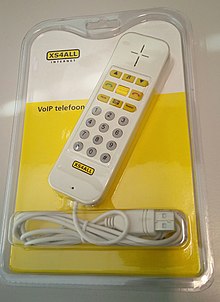| This article needs additional citations for verification. Please help improve this article by adding citations to reliable sources. Unsourced material may be challenged and removed. Find sources: "USB phone" – news · newspapers · books · scholar · JSTOR (December 2009) (Learn how and when to remove this message) |
| This article needs to be updated. Please help update this article to reflect recent events or newly available information. (December 2023) |

A USB phone looks like a traditional telephone, but it has a USB connector instead of an RJ-11. It may be used with most softphones and services like Skype, Sipnet, Sippoint Mini, Net2Phone, MSN Messenger, NetMeeting, Xlite, Skype for Business.
In 2005 XS4ALL Internet BV (the first public internet provider in the Netherlands) supplied all of its DSL users with a USB VOIP Phone, it the idea of Donar Alofs and built by Philips. It came with a browser plugin and people could make and receive calls via this USB Phone via an internet website (webphone.xs4all.nl). Later on, people got DSL modems with RJ-11 VoIP ports and RJ-45 ISDN ports, later the DSL modem/routers were also built-in DECT for making calls with traditional phones.

In 2009, Polycom introduced the CX300 USB phone, optimized for Microsoft Office Communications Server 2007 R2. In its second release (CX300 R2), this USB phone operates as a plug-and-play device with Skype for Business, Microsoft Lync 2013, and Microsoft Lync 2010. A user can communicate using the handset, plug in a headset (RJ9 plug in rear), or use it as a speakerphone when the handset is left on-hook. It is also supported with Skype for Business online which makes it a possible endpoint to use with Office 365 Cloud PBX when connected to a PC running the Skype for Business client.
References
- "Polycom Expands Desktop Phone Portfolio With the Introduction of the Polycom SoundPoint IP 335 and the Polycom CX300". Market Wired. Polycom, Inc.
This article related to telephony is a stub. You can help Misplaced Pages by expanding it. |